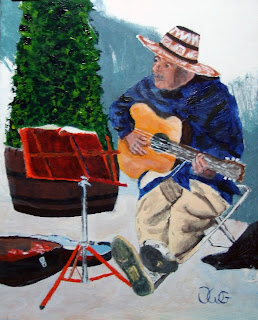
I have missed blogging in the last two weeks. I was very sick with a flu, and had lots of work related things come together and a visit from my children. Insanity, and with it reflection.
Being sick gave me time to think, and think I did. This is the first time all year that I did not draw every day. I was very disappointed, because I even managed to draw during the last flu in the spring, but I just fell asleep and woke up the next day, so that was that. It was these events that upset me, and got me to thinking about what is my objective in art, and how am I doing.
Thank heavens for the visit from my children right after the flu. I restarted my drawing, I relaxed as I toured them around, and when I showed them my art, I got reconnected to it. Now that I am restarting, I get a chance to re-evaluate what I was doing, what worked and what didn't, what's most important and what is not, and most importantly, that I have to scale back because I didn't have any flex time to handle overloads, sickness and emergencies. So, I need to re-evaluate my art goals and give up my believe that I can do everything.
Before I got sick, I was growing rapidly in my art, and was very confused, and reaching out all over trying to find what direction to head in. Now that I am re-starting, I need to re-focus on where I want to grow with my art. My art goals are never clear to me. What I want I can't define. I feel it more than I can conceptualize it.
For instance, I love realism, but I want an artistic twist to it. I can look at abstract art now, and feel it, but can I get that feeling in a realistic piece? How real is real? How loose can I get? I guess I want to be loose, and real, and look artsy all at once.
I want to improve my techniques. I want to be able to draw anything from my mind's eye, and have it look very real. I want to draw people from any angle or position, move the light around, and get it right. Add a background of trees, or a room, or furniture, and get it all right.
I want to paint more, and study composition. Use what I learn in drawing to create my paintings. Get looser, look more real, and more like art than photography.
I want to understand why I seem to draw a lot and paint a whole lot less. I want to paint more. I want to feel the subject in my being, then transfer this to my art. What does "feel" mean? To me "feel" means feel the physical being, then feel my emotions towards that being, and instill both in my work. If it is a living being, I want to feel its feelings too, and bring that into the mix.
My prime goal is to improve my art and keep improving it. That is my prime directive and has not changed. But art is more that creating art. To me it is also trying to earn a living at it, showing it and giving something back to the community with it. These are my secondary goals. I still believe that without the prime objective, these other objectives become meaningless.
When I think about these, I feel I am on the right track, but I have trouble figuring out what I need to do to work on these objectives. This is where the confusion sets in, the impossible balancing act begins, and if I am not careful, where I lose my way.
I know I need to eat and pay my bills, but to stop all art to do it, makes my life meaningless. So to become a better artist, to keep first things first, I need to re-evaluate how I manage my life, what I need to do to exist, and truly make my art and my lifestyle one in the same, or I will get lost again.
I don't think this confusion, and struggle to work on my art objectives will ever disappear. I think this struggle is as much a part of life, as it is a part of art. I wonder if the great artists who have died, died in the struggle. I think so. Only after our death, does the success of our struggle become clear, for while we are alive, we constantly strive to improve, balance and manage. Life is art, art is life. The struggle gives meaning to life.







